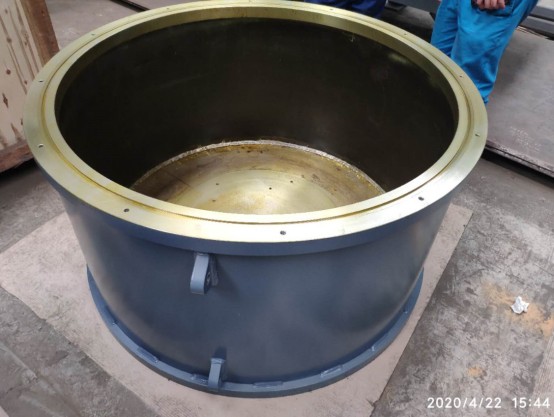The Flywheel mechanical energy storage system is the first commercial four-hour discharge energy storage device, which can store mechanical energy by using the uniform motion of the rotor in a vacuum environment, and the shell device shown here can store 32KWH. The power of a single flywheel can reach tens or even hundreds of megawatts. Electrical energy is stored at night when the price of electricity is low, and mechanical energy is converted into electrical output when the price of electricity is high during the day.

The shell wall thickness is 25mm, the diameter is 1410mm, the height is 875mm, Q235B carbon steel material is selected, the main process involves cutting, winding, welding, machining.

Among them, there is a flange welded at the end of the cylinder, the flange is made of forging material, which can save more materials than the traditional plate cutting, because the product is special and does not allow the way of welding, so the full plate cutting will cause serious material waste. The grooves at the joint between the cover plate and the flange face are sealed with rubber. The bottom surface of the flange groove is required to be completely machined to within Ra1.6, because the groove is deep, we use special custom tools to achieve this machining.


Paint finish
There is a finishing area on the bottom surface of the cylinder, which needs to be polished to within Ra0.8.

Roughness detection

Packing complete
The sealing performance of this product is very high, because when the internal rotor movement must be in a near-vacuum environment, so the requirements for welding seams are extremely harsh, in addition to the traditional magnetic particle detection, we also specially for this product to do precision helium detection. In order to do this test, we made a special roof for detection, vacuum the inside of the cavity to a certain extent with a molecular pump, and then detect the leakage rate of all weld points with a precision helium leak detector. The required leakage rate must be lower than 1.33e-10Pa*m³/s.

Sealing groove rubber ring mounting

Custom top fitting

Helium injection to detect leakage rate in real time
The material of the top plate is also Q235B, with a thickness of 50mm and a diameter of 1410mm. The main difficulty is that the machining surface is extremely demanding, and the outer ring must be machined to within Ra1.6. If the roughness of any point is detected and is not up to standard, the whole machining surface needs to be re-machined, which is a huge challenge for workers and management. We have customized the line work, and after all the processes are completed, the finished surface needs to be reviewed again before transfer, to ensure that there is not a single scratch or dent.

Roof spray booth

Hoisting Process

Outer ring area roughness detection

Finish inspection after spray painting

Apply the finished surface with hard film anti-corrosive oil
 、
、

Packing in container